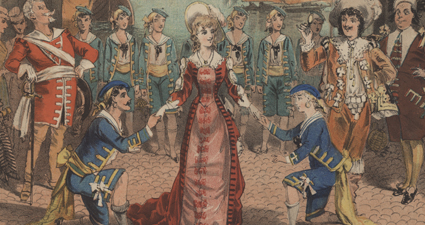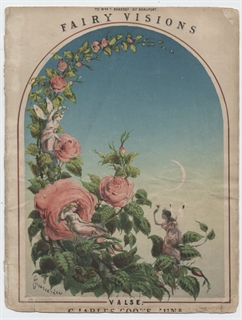 Alfred Concanen (1835 - 1886) was a leading lithographer of the Victorian era, best known for his elaborately illustrated sheet music covers. His covers often featured illustrations of the popular music hall performers of the times or scenes from the songs themselves.
Alfred Concanen (1835 - 1886) was a leading lithographer of the Victorian era, best known for his elaborately illustrated sheet music covers. His covers often featured illustrations of the popular music hall performers of the times or scenes from the songs themselves.
Biography
Concanen’s family originated from the borders of County Roscommon and County Galway, Ireland. One of his ancestors was a well-known artist in that area in the 1760s. His parents were Edward John Concanen (c1814-1868), a portrait painter in Ireland in the early decades of the 19th century, and Mary Ann Concanen (neé Burgess) (1815-1884).
Concanen's birthplace is somewhat of a mystery. Some have him born in Ireland and coming to England later, while others claim he was born in London or Nottingham. He was described as "slight of build with a fair full moustache, something of a dandy, good natured, generous, a play copy of the lions comiques whom he immortalised in his lithographs.”
On September 8, 1858 Concanen married the 18 year-old Mary Anne Tholen (born April 1840) at a registry office in London. They lived at 43 Bloomsbury Street in London, while his studio was at 12 Frith Street in Soho.
According to the 1861 census, Concanen was living in 66 Greek Street in Soho with his wife and two children, Eleanor Maud Concanen (born 1859), and Hugh Tholen Transton Concanen (1861-1917); his occupation was listed as a 'Lithographic Artist'. Later, at their home in St. Mary Square in Lambeth, more children were born: Georgina Susane Concanen (1863-1869), George William Concanen (1864), Kate A. Concanen (c.1864 ), Barry Percy Concanen (1865).
By 1881, census records indicate that time Concanen was married to Ellen (1856 - 1916). (It would seem that Violet Eileen Concanen, born in 1874, was the daughter of his second wife. Victorian Sheet Music Covers lists his second wife as Sarah Cohen, not Ellen). He had two grandsons from his daughter Violet Eileen, the actors Derrick De Marney and Terence De Marney.
Sheet Music and Lithography
Concane n made his sheet music debut in 1860, succeeding John Brandard as master of that art form, a position he held until his own death twenty-six years later. The 1860s were the peak of British music hall tradition and gave rise to the lion comique - such song and 'patter' performers as George Leybourne ('Champagne Charlie'), Alfred Vance - billed as 'The Great Vance', and G. H. MacDermott were hugely popular, and Concanen captured both their acts and their personalities in his beautifully executed lithographs.
n made his sheet music debut in 1860, succeeding John Brandard as master of that art form, a position he held until his own death twenty-six years later. The 1860s were the peak of British music hall tradition and gave rise to the lion comique - such song and 'patter' performers as George Leybourne ('Champagne Charlie'), Alfred Vance - billed as 'The Great Vance', and G. H. MacDermott were hugely popular, and Concanen captured both their acts and their personalities in his beautifully executed lithographs.
Concanen worked with artists and his major partner for years was Lee and frequently the two names appear on music covers.
In Victorian Sheet Music Covers, Ronald Pearsall describes Concanen's style as:
His work falls broadly into two parts-straightforward portraits of the music hall singers in costume as in finely executed and as bright as a new pin, and genre scenes illustrating the title. "The Excursion Train" depicts a platform scene on Victoria Station, a confusion of day-trippers clambering into the Brighton train; "The Flunkey or She Loved a Man With a Monkey" portrays a top-hatted servant in collision with an organ-grinder and his monkey; "Ain’t You Sorry You Dress’d Yourself" shows a disgruntled swell with a dirty footprint on his white waistcoat caused by an urchin doing handsprings on the pavement; "The Husband’s Boat" centres around a bucolic bunch of trippers on board a paddle-steamer to Margate.
Knife-board omnibuses, costermongers’ barrows, carriages and hackney cabs, the hustle and bustle of London life, these are frozen on to the lithographic stone by Concanen. London out-of-doors is his special interest; he did not care for domestic scenes, leaving these to other illustrators.
Not unnaturally, considering the volume of work he turned out, Concanen’s work is uneven, but he never potboiled as some of his colleagues did. It is surprising that in the endless series of illustrations of music hall singers in costume he never falls below a certain level. The quality of the stone seems to have stimulated Concanen, who did not need a new-fangled substitutes such as prepared zinc. (Page 80)
During his career Concanen probably created thousands of designs for sheet music covers, usually charging between two and twenty guineas each, depending on the work involved and the amount of detail desired by the publishers. In addition, in 1869 he illustrated Carols of Lockayne by H. S. Leigh; in 1874 The Wilds of London and, in 1876 Low Life Depths, both by James Greenwood. He also designed a number of theatre posters. He was a member of the London Irish Rifles.
For a period he was a staff illustrator for the Illustrated Sporting and Dramatic News where he sometimes used photographs (which could not be reproduced in the newspapers or magazines of the time) as a basis for his illustrations. At other times he might be seen in a theatre sketching a scene from a new comic opera or in a music hall drawing a performer such as Jenny Hill or Nellie Farren for a sheet music cover.
The theatrical designer Edward Gordon Craig, the son of the noted actress Ellen Terry, recalled meeting Concanen in a tavern in the Strand near to the Lyceum Theatre, where the sixteen year-old Craig was working for Henry Irving. Craig may have been the last person to see Concanen alive, because he died that evening, December 10, 1886, in Marylebone. He was a great influence on future artists such as Mallyon.
Comprehensive collections of his sheet music covers are held by the Victoria & Albert Museum and the British Library, among others.